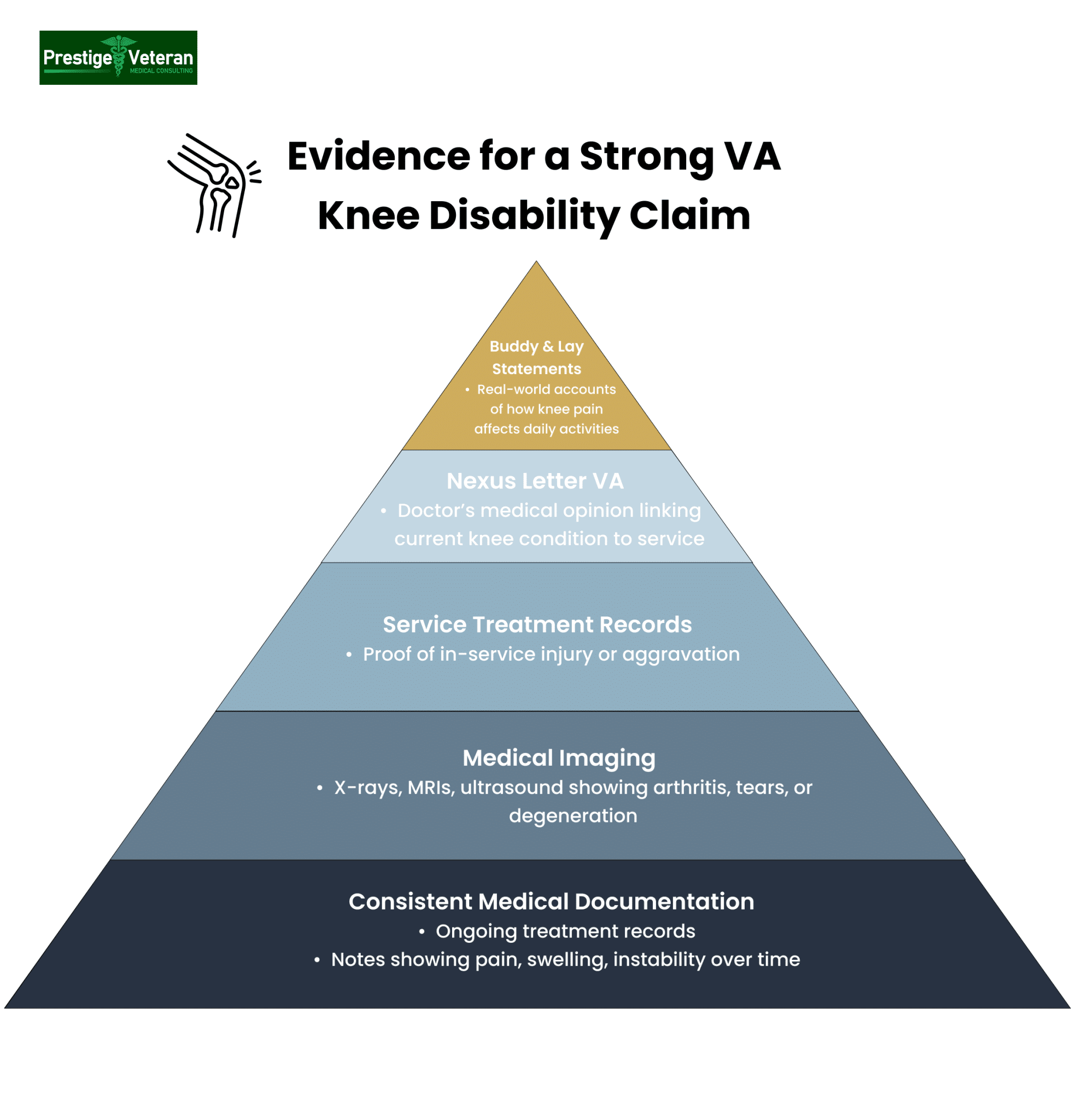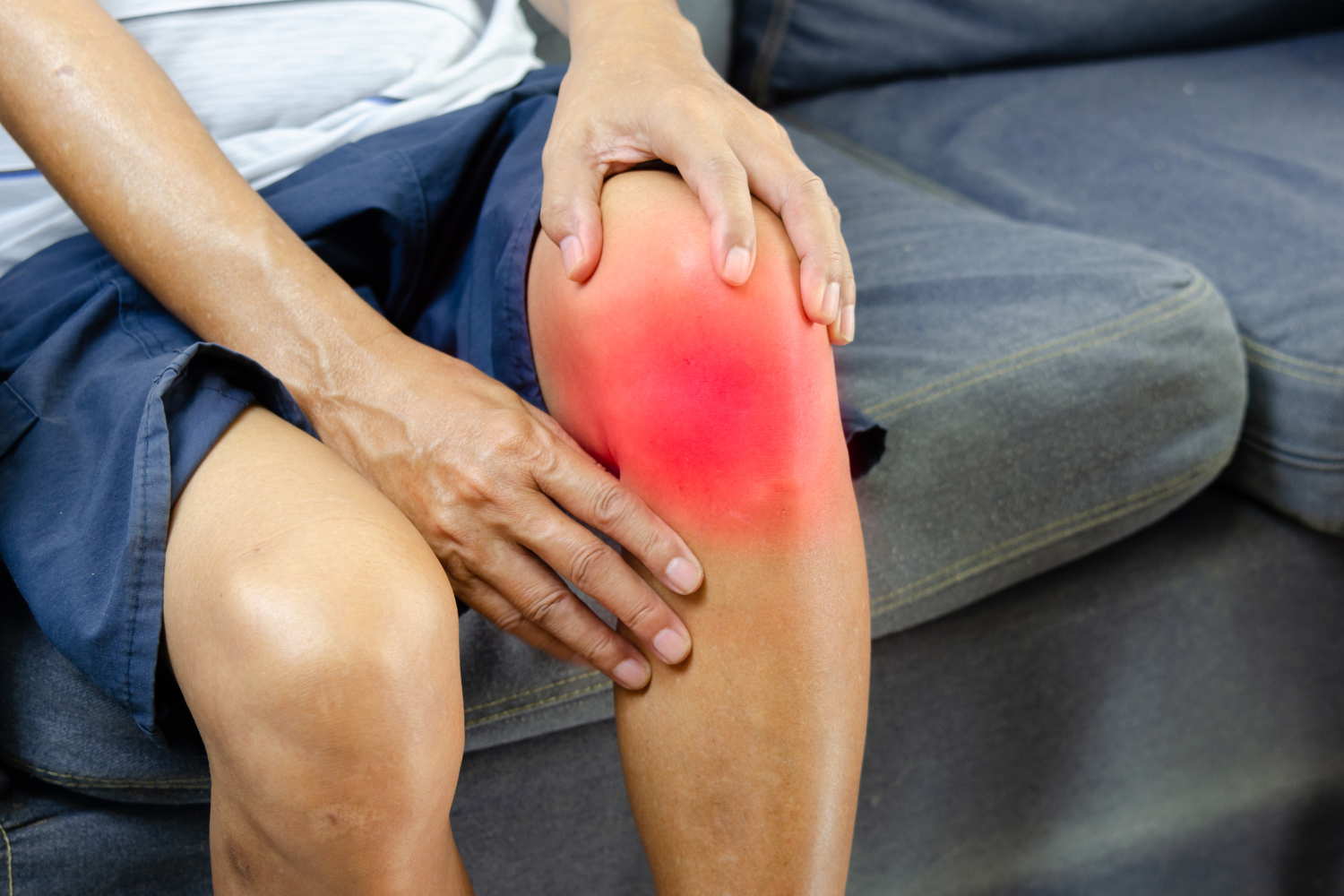Last Updated on 9 August, 2025
Reviewed by: A former U.S. military veteran from Prestige Veteran Medical Consulting Services, experienced in helping veterans navigate VA claims and secure favorable compensation.
Knee pain is a widespread issue among veterans due to the physically demanding nature of military service. According to the Centers for Disease Control and Prevention (CDC), nearly one-third of U.S. veterans were diagnosed with arthritis between 2017 and 2021. From intense training to combat-related injuries, these experiences can lead to long-term knee conditions.
However, navigating the VA disability claims process for knee pain can be complex and overwhelming. This blog offers an overview of key factors that can support your knee disability claim and improve your chances in some instances of receiving the VA compensation you deserve.
Table of Contents
Understanding Knee Pain in Veterans
Over 75% of military-related musculoskeletal injuries involve the lower limb, with the knee being the most commonly affected area. In fact, US Army Soldiers are over 5 times as likely to be diagnosed with incident knee post-traumatic osteoarthritis (PTOA) when compared to those in the general population.
Military-Related Causes
Veterans largely suffer from knee pain due to service-related injuries, such as fractures, dislocations, sprains, or repetitive strain can lead to various knee problems over time. Conditions like arthritis, tendinitis, and bursitis can also contribute to joint pain, causing swelling, stiffness, instability, and reduced mobility.
Looking at statistics, paratroopers are at a higher risk for knee injuries as airborne operations often impact the lower limbs. The MIRROR program collaborated with United States Army paratroopers and found that over 50% sustain injuries annually, with 37% of paratrooper injuries affecting the knee and 26% the ankle.
Symptoms of Knee Disabilities
Veterans may experience knee pain symptoms like sharp pain, swelling, stiffness, redness, weakness, instability, popping sounds, and a crunching sensation. Diagnosing and treating knee pain early is essential for managing symptoms effectively and preventing further damage.
For more information, visit the American Academy of Orthopaedic Surgeons’ OrthoInfo guide to knee pain.
Common Knee Conditions Eligible for VA Disability Benefits
The Department of Veterans Affairs (VA) offers disability compensation for various knee conditions connected to military service. Understanding which joint pain conditions qualify for VA disability benefits is crucial for veterans seeking compensation.
Several knee conditions may qualify veterans for VA disability compensation, including but not limited to:
Arthritis in the Knee
- Osteoarthritis: A CDC report found that arthritis is 60% more prevalent than among nonveterans. The most common form of arthritis where cartilage breakdown leads to joint pain, stiffness, and swelling.
- Rheumatoid Arthritis: An autoimmune disorder that causes chronic inflammation in the knee joints, often leading to severe pain and deformity.
- Post-Traumatic Arthritis: Develops after a knee injury such as a fracture, ligament tear, or dislocation sustained during service.
- Major Joint Rule: Under VA regulations, the knee is considered a major joint. If arthritis is confirmed by X-ray and causes painful motion, a minimum 10% rating may be assigned, even if range of motion loss is minimal.
Ligament Injuries
- ACL, MCL, and PCL Tears: Damage to these ligaments can cause instability, difficulty walking, and long-term degenerative changes.
- Chronic Instability of the Knee: A sensation of the knee giving way or moving side-to-side, usually requiring bracing or assistive devices.
Meniscus Injuries
- Tears: Damage to the cartilage cushioning the knee joint, leading to pain, locking, or swelling.
- Dislocation: The meniscus can become displaced, causing severe instability and joint dysfunction.
Bursitis
Inflammation of the bursae, small fluid-filled sacs that cushion knee joints, causing pain, swelling, and limited movement.
Tendonitis & Patellar Tendonitis
Overuse or injury can inflame the tendons around the kneecap, leading to pain, tenderness, and decreased flexibility.
Osteomyelitis & Tuberculosis of the Knee
Rare but serious bone infections that may result from injuries, wounds, or systemic illness during military service.
Effusion (Fluid on the Knee)
Excess fluid accumulation in or around the joint, leading to swelling, stiffness, and reduced range of motion.
Hyperextension (Genu Recurvatum)
Overextension of the knee joint beyond its normal range, which often causes ligament strain and instability.
Ankylosis (Stiffness or Immobility)
Severe stiffness or fusion of the knee joint that restricts or prevents movement, often caused by injury, arthritis, or infection.
Gout Affecting the Knee
A type of inflammatory arthritis caused by uric acid crystal buildup in the joint, leading to sudden and severe pain.
Runner’s Knee (Patellofemoral Pain Syndrome)
Pain around the front of the knee and kneecap, common in military service members undergoing heavy physical training.
Shin Splints (Secondary to Knee Injury)
Inflammation of muscles and tendons in the shin area, sometimes developing as a secondary condition to altered gait from knee injuries.
Osgood-Schlatter Disease
A painful inflammation below the kneecap caused by repetitive stress on the patellar tendon, sometimes aggravated by military training.
To qualify for compensation, veterans must establish a service connection, proving that their knee condition was caused or worsened by military service. This often involves medical documentation, service records, and, often, completing a Compensation and Pension (C&P) exam. The VA uses a Disability Benefits Questionnaire (DBQ) to assess the severity of knee and leg impairments and assign a disability rating.
Service Connection for Knee Conditions
Establishing a service connection for knee disabilities involves proving how military service contributed to the condition. This can be done through direct service connection, secondary service connection, either of which can be demonstrated by either causation or aggravation of a pre-existing condition. Each path requires specific evidence and has unique criteria for approval.
Direct Service Connection for Knee Pain
A direct service connection is established when a veteran can directly link their knee condition on a causal or aggravational basis to an incident or injury that occurred during their military service. To win a VA knee claim, veterans submit three key components to prove a direct connection: a current medical diagnosis, evidence of an in-service event or injury, and a medical nexus linking the two.
Secondary Service Connection for Knee Pain
A secondary service connection claim applies when an already service-connected primary condition causes the veteran to injure or overuse another condition or joint, often by things like adjusting their movement or posture, leading to a secondary condition. For example, a veteran with a back injury develops knee arthritis from altered walking patterns, making it a secondary service connection.
These are the common secondary conditions related to knee pain:
- Hip and Back Pain: Changes in gait to avoid knee pain can strain the hips and lower back.
- Ankle and Foot Problems: Altered walking patterns may lead to injuries in the ankle and foot.
- Degenerative Arthritis: Overuse of other joints due to knee instability can accelerate arthritis.
- Muscle Weakness: Reduced mobility may weaken surrounding muscles, leading to further instability.
- Nerve Damage: Severe knee injuries or knee replacement surgeries can affect nearby nerves, causing pain or numbness.
- Spinal Issues from Altered Gait: Long-term gait changes due to knee problems can contribute to spinal misalignment or degenerative issues.
- Mental Health Conditions: Chronic knee pain can contribute to depression and anxiety due to decreased mobility and quality of life.
Proper medical documentation, service treatment records, and a nexus opinion clearly establishing how the primary knee condition caused or aggravated the secondary disability are vital for securing additional compensation. Recognizing and claiming secondary conditions can increase a veteran’s overall disability rating for knee pain, leading to higher monthly benefits in many cases.
Aggravated Service Connection for Knee Pain
Aggravation applies when a pre-existing knee condition is worsened beyond its natural progression due to military service. For example, a veteran with pre-existing mild knee pain regularly carried heavy equipment and participated in physically demanding tasks.
After military service, the veteran now experiences severe knee instability and requires replacement surgery. Providing medical evidence of how the veteran’s military deployment deteriorated the knee condition beyond normal aging may strengthen this particular example of a VA claim for aggravation.
VA Knee Rating Chart Explained
Disability ratings reflect how significantly a knee condition impairs a veteran’s ability to work and perform daily activities. Knee disability ratings range from 0% to 100% and are assigned based on the severity of symptoms, the degree of movement limitation, pain, instability, and the need for assistive devices.
Normal Range of Motion for the Knee
- Flexion (bending): 0° to 140°
- Extension (straightening): 0° is fully straight (0° represents complete extension)
These values represent the typical, healthy range of motion for the knee joint. Any measurable loss of motion, particularly when accompanied by pain, may affect VA disability ratings.
Under 38 CFR § 4.71a – Schedule of ratings—musculoskeletal system, the Department of Veterans Affairs (VA) evaluates knee disabilities through specific diagnostic codes.
1. Limitation of Flexion of the Knee — Diagnostic Code 5260
This is the most common service-connected knee condition, referring to restricted bending of the knee inward toward the body. The VA rates the limitation of knee flexion strictly based on the range of motion rather than how much pain it causes.
- 30% – Flexion limited to 15°
- 20% – Flexion limited to 30°
- 10% – Flexion limited to 45°
- 0% – Flexion limited to 60°
2. Limitation of Extension of the Knee — Diagnostic Code 5261
This condition involves the inability to fully straighten the knee, which makes standing and walking painful and difficult. Higher VA ratings are given for more severe limitations in extension.
- 50% – Extension limited to 45°
- 40% – Extension limited to 30°
- 30% – Extension limited to 20°
- 20% – Extension limited to 15°
- 10% – Extension limited to 10°
- 0% – Extension limited to 5°
3. Instability of the Knee — Diagnostic Code 5257
Instability refers to excessive movement of the knee joint, often due to damaged ligaments, resulting in the knee giving out or dislocating. VA disability ratings for knee instability depend on the severity:
- 30% – Severe instability requiring both bracing and assistive devices (cane, crutch, or walker)
- 20% – Moderate instability with prescribed bracing or assistive devices
- 10% – Mild instability without the need for assistive devices
This diagnostic code also covers patellar instability, where the kneecap becomes displaced.
4. Ankylosis of the Knee — Diagnostic Code 5256
Ankylosis refers to abnormal stiffening and immobility due to bone fusion, which severely limits knee function and often requires assistive devices. The degree of immobility affects the ankylosis of the knee VA rating:
- 60% – Flexion at 45° or more (extremely unfavorable)
- 50% – Flexion between 20° and 45°
- 40% – Flexion between 10° and 20°
- 30% – Full extension or slight flexion between 0° and 10°
5. Total Knee Replacements — Diagnostic Code 5055
Veterans who have undergone a total knee replacement surgery with prosthetics are awarded a temporary rating of 100% disability for the first four months post-surgery to allow for recovery. After this period, a Compensation & Pension (C&P) exam is conducted to determine the veteran’s long-term VA knee disability rating based on their recovery and ongoing symptoms.
- 60% – Chronic severe pain or weakness
- 30% – Intermediate symptoms like moderate pain and limited motion
- Minimum rating: 30%, even if motion has improved
6. Partial Knee Replacements
Partial knee replacements do not have a dedicated diagnostic code. They are rated based on resulting symptoms, such as pain, limited motion, or instability, often under Diagnostic Codes 5260, 5261, or 5257.
Additional Knee Conditions and Ratings
- Meniscus injuries (Diagnostic Codes 5258 & 5259) are rated at 20% for frequent locking, pain, and fluid buildup, and 10% for symptomatic removal of cartilage.
- Tibia and fibula impairments (Diagnostic Code 5262) are rated at 40% for nonunion with loose motion requiring a brace, 30% for malunion with marked knee or ankle disability, and 10–20% for moderate to slight disabilities.
- Genu recurvatum (Diagnostic Code 5263) receives a 10% rating for knee hyperextension causing weakness and instability.
Painful Motion Rule
Under the painful motion VA rating rule (38 CFR § 4.59), if pain is documented during movement, even without severe range of motion loss, the VA must assign at least a 10% rating for that major joint. The onset of pain should be recorded at the exact degree it begins during testing, as this can directly influence your VA knee disability rating.
Pro Tip: If your pain starts before the end of motion (for example, pain begins at 35° flexion even though you can move to 30°), the VA can rate you based on where pain starts, not just the final measurement.
Functional Loss Rule
The VA functional loss rule under 38 CFR § 4.40 evaluates how pain, weakness, swelling, instability, or fatigue limits your ability to function, especially during repetitive use or flare-ups. Even if your range of motion appears normal, a higher VA knee pain rating can be justified when you experience:
- Chronic pain impacting daily activities
- Swelling and instability
- Use of braces or assistive devices (canes, crutches, walkers)
Knee Arthritis and the Major Joint Rule
The VA’s Major Joint Rule guides disability ratings for veterans with knee arthritis. Initially, the VA assesses the knee’s range of motion using Diagnostic Codes 5260 (limitation of flexion) and 5261 (limitation of extension). If the range of motion appears normal but pain persists, the VA applies Diagnostic Code 5003 for arthritis.
When arthritis is confirmed by X-ray, the VA assigns a 10% or 20% disability rating based on the severity of the joint pain and whether one or both knees are affected. This approach ensures veterans receive the maximum benefits for their knee arthritis.
Separate VA Disability Ratings for Multiple Knee Conditions
The VA can assign separate disability ratings for different knee impairments if they affect distinct functions. For example, a veteran may receive separate ratings for limited flexion (bending) and limited extension (straightening) of the knee. However, the VA prohibits “pyramiding,” or rating the same symptom twice. Proper documentation of separate knee limitations may help veterans ensure fair compensation.
Total Disability Based on Individual Unemployability (TDIU)
Veterans unable to work due to severe knee problems may qualify for TDIU, providing compensation at the 100% disability rate, even without a 100% combined rating. To be eligible, veterans must show how their knee disability prevents gainful employment.
Qualification requires either:
- One disability rated at 60% or more
- Multiple disabilities combining to a 70% VA rating with at least one at 40%
For some veterans, VA unemployability for knee injury is granted when chronic pain, instability, or the need for mobility aids prevents any form of gainful employment. Additionally, filing for secondary disabilities like musculoskeletal issues or arthritis with primary knee conditions can help meet the TDIU requirements.
Proving TDIU involves showing not just medical evidence, but also work history and vocational impact.
Bilateral Factor
If both knees are affected due to military service, the VA applies the bilateral knee rating rule under 38 CFR § 4.26, increasing a veteran’s combined disability rating. An example of VA bilateral factor calculation may look like:
- Step 1: Combine 20% (right knee) and 10% (left knee) using VA math → 28% (not 30%).
- Step 2: Add 10% of that combined value (2.8%) for the bilateral factor → 30.8%.
- Step 3: Round 30.8% to the nearest 10% → 31% becomes 30% or 40%, potentially increasing the monthly payment.
Veterans with service-connected knee conditions impacting both limbs, whether it’s pain, limited motion, instability, or post-surgical complications, are entitled to fair VA compensation that supports their lives.
By understanding the VA knee disability rating criteria and special rules influencing the claim, veterans can ensure they get deserved benefits. Discover the 2025 VA disability compensation rates applicable for your VA knee disability here.
Understanding the VA Knee Rating Chart and Diagnostic Codes
The VA knee rating chart helps veterans understand what disability percentage they might qualify for based on their knee condition. Each VA diagnostic code knee matches a specific injury or limitation, helping with claim preparation. Under the 38 CFR § 4.71a knee rating system, the VA assigns percentages based on severity, range of motion, and documented medical evidence.
VA Knee Rating Chart – Diagnostic Codes and Criteria
| Diagnostic Code (DC) | Condition | VA Disability Rating (%) | Criteria / Description |
| DC 5003 / 5010 | Arthritis (Degenerative or Traumatic) | 10%, 20% | Rated based on limitation of motion; 10% for X-ray evidence with painful motion; 20% if multiple major joints affected. |
| DC 5256 | Ankylosis of the Knee | 30%, 40%, 50%, 60% | 60% – Flexion at ≥45°; 50% – 20–45°; 40% – 10–20°; 30% – 0–10°. |
| DC 5257 | Recurrent Subluxation / Lateral Instability | 10%, 20%, 30% | 30% – Complete ligament tear with assistive device & bracing; 20% – Moderate instability with prescribed device; 10% – Slight instability without device. |
| DC 5258 | Dislocated Semilunar Cartilage | 20% | Frequent locking, pain, and joint effusion (fluid). |
| DC 5259 | Removal of Semilunar Cartilage | 10% | Symptomatic after surgical removal of meniscus. |
| DC 5260 | Limitation of Flexion | 0%, 10%, 20%, 30% | 30% – Flexion ≤15°; 20% – Flexion ≤30°; 10% – Flexion ≤45°; 0% – Flexion ≤60°. |
| DC 5261 | Limitation of Extension | 0%, 10%, 20%, 30%, 40%, 50% | 50% – Extension ≤45°; 40% – ≤30°; 30% – ≤20°; 20% – ≤15°; 10% – ≤10°; 0% – ≤5°. |
| DC 5262 | Impairment of Tibia and Fibula | 10%, 20%, 30%, 40% | 40% – Nonunion with loose motion, requiring brace; lower ratings for malunion with varying severity. |
| DC 5263 | Genu Recurvatum (Hyperextension) | 10% | Acquired, traumatic, with weakness and instability in weight-bearing. |
| DC 5055 | Total Knee Replacement | 30%, 60%, 100% (temporary) | 100% – First 4 months post-surgery; 60% – Severe pain/weakness; 30% – Minimum rating after replacement. |
How to Use the VA Knee Rating Chart
- Match your medical diagnosis to the diagnostic code above.
- Review the percentage criteria to understand your likely rating.
- If your symptoms meet criteria in multiple DCs (e.g., instability + limited motion), you may qualify for separate ratings without pyramiding.
- Always provide medical evidence such as X-rays, MRIs, or ROM (range of motion) testing.
Proving Service Connection for Knee Pain
Proving service connection for knee pain is essential for veterans seeking VA disability compensation. To secure a VA rating for knee pain, a veteran must establish a service connection by satisfying three key criteria:
1. Current Medical Diagnosis
The foundation of any successful VA disability claim is a current medical diagnosis provided by a qualified medical professional. Diagnoses like osteoarthritis, meniscus tears, or ligament damage must directly explain the pain experienced. Ensure that the medical records detail the specific knee injury rather than attributing pain to general discomfort or aging.
2. In-Service Event or Injury Documentation
Veterans must provide evidence of an in-service event, injury, or exposure that caused or aggravated their knee disability. This documentation can include service treatment records (STRs), incident reports, deployment records, or personal medical logs detailing symptoms kept during service. Consistent and detailed documentation of the service-connected disability may greatly strengthen the VA claim.
3. Medical Nexus
The medical nexus is a critical component in linking a veteran’s knee injury or condition to their military service. It is important to note that a nexus can be provided at the VA C&P exam. A medical nexus letter is a narrative document that outlines the nexus and is not a requirement but may bolster a veteran’s evidence in some cases.
A qualified medical provider, in this case, a primary care physician, orthopaedic surgeon, or an independent medical examiner (IME), can write a nexus letter for knee conditions. They review the veteran’s medical history and offer an expert opinion on whether the knee condition is “at least as likely as not” connected to service.
Lay statements from veterans, family, or service members describing the onset, frequency, and daily impact of knee pain can also strengthen compensation claims, especially when there is a lack of medical evidence.
Building a Strong VA Claim with a Medical Nexus Letter for Knee Pain
A nexus letter presents a clear medical opinion linking a veteran’s current knee condition directly to their military service. This professional document can significantly impact the outcome of a VA disability claim in some cases. An effective nexus opinion letter is supported by detailed medical reasoning that refers to service treatment records, diagnostic imaging (X-rays, MRIs), and relevant medical literature. The letter should also highlight the credentials and expertise of the physician to establish credibility.
In close or borderline disability cases, a strong nexus letter can help trigger the VA benefit of the doubt rule, helping ensure that any reasonable uncertainty is decided in the veteran’s favor.
To build a strong VA disability claim for knee pain, veterans should consult with accredited legal professionals who will advise on the following when applicable:
- Gather medical records documenting diagnoses, treatments, and persistent symptoms.
- Provide service records or incident reports detailing the in-service event causing or worsening the knee condition.
- Obtain a professionally written nexus letter that connects the knee pain to military service if needed.
Prestige Veteran specializes in creating comprehensive, evidence-based nexus letters. Our skilled medical professionals thoroughly review service records and medical histories to craft nexus opinions that strengthen knee-related VA claims.
Veterans and their accredited legal representatives will gather evidence to file a VA disability claim for knee pain, often by submitting VA Form 21-526EZ with comprehensive medical records, service documents, and a detailed nexus letter to maximize their chances of receiving fair VA disability benefits.
Compensation & Pension (C&P) Exam for Knee Pain
The VA Compensation & Pension (C&P) exam for knee pain is an essential step in determining a veteran’s disability rating. Conducted by a VA or VA-contracted examiner, the assessment measures range of motion using a goniometer, reviews medical records, and evaluates how pain, instability, and functional loss affect daily activities.
How to Prepare for the Knee C&P Exam:
A well-prepared veteran for the C&P exam is more likely to receive an accurate evaluation. Before the exam:
- Gather all relevant medical records, including a completed DBQ Knee and Lower Leg Conditions form.
- Keep a detailed symptom diary tracking pain levels, instability, swelling, and flare-up triggers.
- Note any secondary conditions related to knee pain, such as hip, back, or ankle issues.
During the Exam:
- Be honest and detailed with your answers; don’t downplay your pain or mobility issues.
- Stop movement exactly where pain begins so the examiner can accurately measure flexion or extension.
- Explain how bad days affect your walking, standing, lifting, or climbing stairs.
After the Exam:
- Read your C&P examination report to identify mistakes or missing details.
- Submit any additional medical evidence right away.
The more prepared and truthful you are during the Compensation and Pension exam, the better your chances of getting a fair VA knee pain disability rating.
Disability Benefits Questionnaire (DBQ) for Knee Conditions
When attending the C&P exam, the examiner will complete a Disability Benefits Questionnaire (DBQ) for Knee and Lower Leg Conditions. The DBQ gathers detailed information about the injury, symptoms, treatment history, and daily impact.
Providing thorough and honest information on the DBQ allows the examiner to better understand the extent of the veteran’s knee impairment.
Download the Disability Benefits Questionnaire (DBQ) for Knee and Lower Leg Conditions to support your VA disability claim for knees.
Consulting a VA-accredited representative, such as a Veterans Service Officer (VSO), claims agent, or VA-accredited attorney, ensures proper guidance in filing disability claims and navigating complex VA processes to maximize benefits.
5 Expert Tips to Increase Your VA Rating for Knee Pain
Many veterans receive an initial disability rating for knee pain that doesn’t reflect the true impact of their condition. Over time, pain can worsen, mobility can decline, and related conditions can develop. Knowing how to navigate the VA system can help you increase your VA knee rating and secure the benefits you’ve earned.

1. Filing for a Rating Increase After Worsening Knee Pain
If your knee condition has deteriorated since your last decision, you can request a new evaluation. Keep a record of changes, such as reduced range of motion, increased instability, or more frequent flare-ups, and support it with updated medical exams and imaging.
Example: A veteran whose knee flexion worsens from 45° to 30° could see their rating rise from 10% to 20% under VA guidelines.
2. Filing Secondary Conditions in the VA Knee Claim
Knee injuries often set off a chain reaction in the body. Back strain, hip misalignment, or even problems in the opposite knee can all develop from altered gait and compensation. By documenting these as secondary service-connected disabilities, you may significantly increase your combined VA knee rating.
3. Filing for the Bilateral Factor
If you have service-connected disabilities in both knees, or a knee on one side and another lower-limb condition on the other, you might qualify for the VA bilateral factor. This bilateral calculation adds 10% to the combined rating for those conditions. Even a minor rating increase can lead you to a higher monthly compensation.
4. Avoiding Pyramiding in Multiple Ratings
The VA prohibits “pyramiding,” which means it doesn’t rate the same symptom twice under different codes. However, distinct impairments, like limited flexion and recurrent instability, can receive separate ratings without overlap.
Evidence that can help identify and avoid pyramiding in multiple VA ratings includes:
- Range of motion tests using a goniometer
- Stability or ligament tests
- X-rays or MRI results
- Separate medical diagnoses for each impairment
- Physician notes
- Lay statements
Correctly identifying these separate issues can lead to a higher VA rating for knee pain without violating VA regulations.
5. Appealing a Low Rating Decision
If you believe your original rating was too low, don’t wait. You have one year to appeal your VA knee claim. This can be done through a VA supplemental claim with new evidence, a higher-level review, or an appeal to the Board of Veterans’ Appeals.
Pro Tip: Working with an accredited VA disability attorney or Veterans Service Officer (VSO) can provide valuable guidance and boost your chances of winning a case.
VA Claim Mistakes That Can Lower Your Knee Pain Rating
If you are pursuing or appealing a VA knee disability rating, avoiding these mistakes can help you protect your claim and compensation.
1. Not Applying the Painful Motion Rule
Failing to ensure the VA documents painful motion in a major knee joint, such as in arthritis, torn meniscus, or chronic knee pain, can cost at least a 10% VA disability rating, even when range of motion loss seems minimal.
2. Overlooking Functional Loss During Flare-Ups
Ignoring how flare-ups affect movement, endurance, or stability, especially in disabilities like osteoarthritis or ankylosis, can result in a lower VA knee pain rating. Without clear documentation, the VA may undervalue claims related to knee flexion or extension limitations.
3. Ignoring the Bilateral Factor
Missing the bilateral knee rating rule when both knees or lower limbs are affected can reduce monthly VA compensation. This oversight can prevent the extra 10% boost the VA applies to combined disability ratings.
4. Improperly Using a Goniometer in Range of Motion Testing
Allowing examiners to estimate rather than measure with a goniometer can lower your VA knee flexion rating. Inaccurate readings, common in VA arthritis or instability cases, can lower your disability percentage and monthly compensation.
5. Not Linking Secondary Conditions to Knee Pain
Neglecting to connect secondary conditions, like hip pain, back strain, or headaches from altered gait, to knee injuries can limit your VA disability rating. Proper linkage strengthens claims and increases overall compensation.
Still denied VA knee claim? Consulting a VSO or accredited VA attorney can help correct errors and push for the higher VA rating for knee pain you’ve earned.
Real-World VA Knee Disability Claims
Case Study 1 – Appealing a Low Initial Rating for a Knee Injury
A 41-year-old Air Force veteran injured her right knee during training. The VA initially assigned a 0% rating, citing minimal motion loss. She appealed by submitting MRI results, goniometer-based ROM measurements, and a private nexus letter confirming painful motion per VA’s rule. On review, the VA awarded a 10% rating for painful motion plus 20% for instability, raising her combined rating to 30% and securing back pay for the appeal period.
Case Study 2 – Secondary Service Connection Boosts VA Rating
A 46-year-old Marine veteran had a 20% rating for left knee instability after a service-related ACL tear. Years of altered gait caused chronic lower back pain. With support from a VSO, he linked the back pain as a secondary service-connected condition using medical records and a strong nexus letter. The VA granted a 40% combined rating, applying the bilateral factor for lower limb involvement. This increased his monthly compensation and opened eligibility for vocational rehabilitation services.
Disclaimer: This article is for informational purposes only and is not a substitute for professional legal or medical advice. Please consult VA-accredited representatives for personalized guidance.
Conclusion
Securing VA disability compensation for knee pain is more than just filing a claim—it’s about presenting a compelling case that reflects the true impact of your service-related injury. By understanding how to connect your knee condition to military service, providing strong medical evidence, and leveraging expert support from accredited legal professionals, you can take control of the process. With persistence and the right strategy, you can secure the compensation you deserve and move forward with much-needed peace of mind.
FAQs
What is the average VA rating for knees?
As per the VA’s annual benefits report, the average VA disability rating for knee conditions typically ranges between 10% and 30%, depending on pain, range of motion loss, and instability.
What is the highest VA rating for a knee disability?
The maximum schedular rating for a single knee is 60%, though some veterans qualify for higher combined ratings or Temporary 100% VA disability for knee replacement surgery or other major procedures.
How can I get 30% VA disability for my knees?
To receive a 30% VA knee rating, you must show severe instability, flexion limited to 15°, extension limited to 20°, or ongoing moderate symptoms after total knee replacement.
What is the range of motion for the knee for VA disability?
For VA disability ratings, the normal range of motion for the knee is from 0 degrees (full extension) to 140 degrees (full flexion).
How do I prove my knee disability is service-connected?
To prove your knee condition is service-connected, you need a current medical diagnosis, documented evidence of an in-service injury or event, and a medical nexus linking the condition to your service.
What is the VA rating for painful joints?
Under the VA’s painful motion rule, a major joint like the knee with documented pain during movement is entitled to at least a 10% disability rating, even with minimal motion loss.
What is the VA disability rating for arthritis in the knee?
Knee arthritis confirmed by X-ray is rated 10% or 20% under Diagnostic Code 5003, with higher ratings possible for significant motion loss or instability.
How does the VA rate limitation of knee flexion?
The VA rates limitation of knee flexion from 0% for 60° or more to 30% for flexion limited to 15°, based solely on measured range of motion.
How does the VA calculate ratings for bilateral knee conditions?
When both knees are service-connected, the VA applies the bilateral factor under 38 CFR § 4.26, increasing the combined rating by 10%.
What is the VA disability rating after knee surgery?
After total knee replacement, the VA grants a temporary 100% rating for four months, followed by a 30%–60% rating based on ongoing pain, weakness, or limited motion.
What is the 38 CFR knee rating chart?
The VA knee rating chart in 38 CFR § 4.71a assigns 0%–100% ratings based on diagnostic codes for flexion, extension, instability, arthritis, ankylosis, and joint replacements.
What is the VA rating for knee popping?
The VA rates knee popping under Diagnostic Codes 5257–5261 at 0%, 10%, 20%, and 30% depending on pain, instability, and limited motion.
What is the VA rating for Chronic Osteoarthritis?
The VA usually rates chronic osteoarthritis under Diagnostic Code 5003 at 10% for one or two major joints with painful motion and up to 20% for multiple major joints or limited motion confirmed by X-ray.
Also read: Arthritis in Veterans: VA Disability Ratings and Criteria Explained
At Prestige Veteran Medical Consulting, a veteran-owned company, we specialize in Independent Medical Opinions (IMOs) known as Nexus letters.
Our purpose is to empower YOU, the veteran, to take charge of your medical evidence and provide you with valuable educational tools and research to guide you on your journey.
Understanding the unique challenges veterans face, our commitment lies in delivering exceptional service and support.
Leveraging an extensive network of licensed independent medical professionals, all well-versed in the medical professional aspects of the VA claims process, we review the necessary medical evidence to incorporate in our reports related to your VA Disability Claim.
Prestige Veteran Medical Consulting is not a law firm, accredited claims agent, or affiliated with the Veterans Administration or Veterans Services Organizations. However, we are happy to discuss your case with your accredited VA legal professional.













